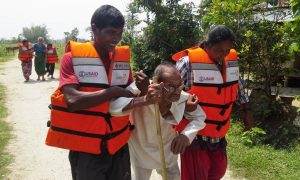Many countries in the eastern hemisphere are entering the annual monsoon season. It’s a time when preparation and resilience are especially important, particularly for communities living in flood-prone areas.
Practical Action’s Senior Disaster Risk Reduction Advisor, Dr. Mirianna Budimir, was recently interviewed for Pacific Prepared, a Disaster Preparedness and Resilience radio show that airs from the Philippines to Hawaii and across Australia, New Zealand and the South Pacific. The show is hosted by Radio Australia and shares information, guidance, and advice to populations across the region on preparing in advance of disasters.

Evacuation drills, organised by local volunteers, are one way we support communities to prepare for monsoonal flooding
The episode, Follow official advice and adapt traditional knowledge – seeking the perfect early warning system, features stories on what to pack in your go-bag; preparing for disasters in Tonga now the tropical cyclone season is over; and relocating an entire town exposed to hazards.
In this episode, Mirianna spoke with Aaron Kearney and Josaia Nanuga about the “perfect” early warning system (EWS) and how to communicate effectively and to the right people. They discuss the current gaps in research and guidance, and how an EWS should be designed to keep people at the centre.
Listen to the podcast (Practical Action’s interview is at 18:40)
Effective communication and dissemination of early warnings to remote areas
Early warnings are only effective if they are communicated so that information reaches the right people, in the right way and at the right time in order to take action ahead of a disaster. Recent advancements in technology have meant that early warnings are now better able to reach people in remote areas who may have previously been missed out. These early warnings should be sent through multiple channels such as SMS (text messages), radio, TV, email, and sirens in order to reach as many people as possible.
The warnings themselves must be clear, understandable, useful and accessible. They should be tailored for different audiences and take account of potential barriers to accessing and acting on information. For example, we must consider local languages, literacy levels, sensory impairments, and ensure that all warnings are free from technical jargon in order to improve ease of understanding and uptake.
Gaps in research and lack of integration between traditional knowledge and national systems
There is often a lack of integration between national early warning systems and local, traditional and indigenous knowledge. Local communities have a wealth of experience and knowledge on where hazards occur, where is safe, what to do, and how to cope, and this needs to be better recognised as being a complimentary source of information to the more formal, “scientific” knowledge generated at the national level. The different types of knowledge can work together and should not be viewed as separate, competing sources of information.
There is well documented guidance on the more technology-based aspects of EWS (e.g. monitoring), yet there is a lack of practical guidance around how to work collaboratively across organisations. There is also a gap in research focusing on early warning and groups experiencing marginalisation based on a range of intersecting factors such as gender, race, socioeconomic status, sexual orientation, among others.
Practical Action Consulting has conducted a number of studies looking primarily at gender but also other social inequalities that might affect someone’s access to early warnings, their ability to respond and their experience of that hazard. We have also published a number of reports on gender, age and EWS, and how these factors interact with, and affect, disaster risk.
To read more, follow the links below:
- Gender Transformative Early Warning Systems
- Missing Voices: Experiences of Marginalised Genders Groups in Disaster in Nepal and Peru
- Gender and Age Inequality of Disaster Risk
As part of the Asian Development Bank’s ASEAN Australia Smart Cities Trust Fund, we are currently working with the ‘Baguio City Smart Flood Warning, Information and Mitigation System’ project to conduct research into gender and social inclusion within Baguio City and advise recommendations to ensure the EWS is designed to be inclusive of needs of the most vulnerable.
Taking a holistic, people-centred approach
A holistic, people-centred approach focusses on the original purpose of an EWS: is the right information reaching the right people with enough time to act? It’s about looking at the bigger picture with people as a priority and identifying any gaps or bottlenecks and taking account of what’s needed in order for warnings to be effective beyond monitoring of environmental conditions and sending out messages. Effective, people-centred approaches recognise the importance of identifying who’s at risk, what needs and capabilities they possess, and what information they need to take action.
Placing people at the centre will impact the way in which the entire EWS is designed. The context and the needs and capabilities of communities should inform, for example, the type of sensors used, which maps and information are produced, who’s included in preparation, and how to actually send out the warnings.
Read more about holistic, people-centred design.
Coming soon on Pacific Prepared
This episode is the first in a series which will be shared over the coming weeks. Future episodes will delve deeper into topics such as:
- Understanding risk
- Undertaking evidence-based monitoring and warning
- Developing response capacities
- Addressing cross-cutting issues
With many communities around the world entering the annual monsoon season, preparation and resilience are vital topics. Alongside our work on the ground with communities, we’ll be taking every opportunity to share information, guidance, and advice to populations across the region on preparing in advance of disasters.